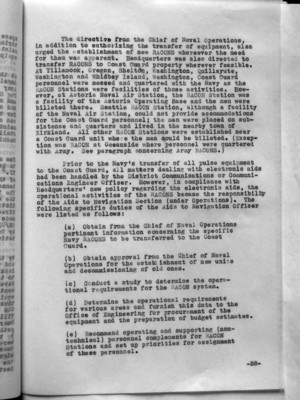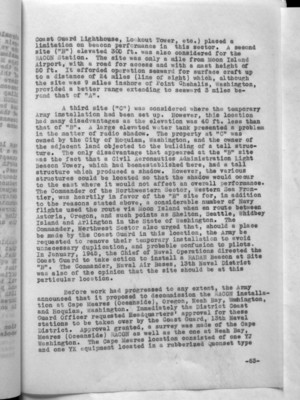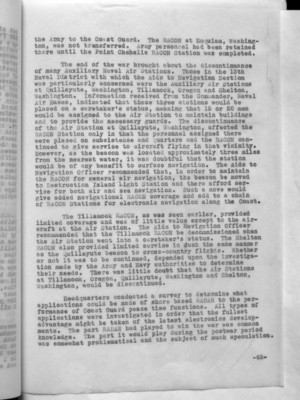Pages That Mention Shelton
Coast Guard District narrative histories 1945
11
labor consumed far too much valuable time, and so it became expedient that there be a swifter method. By 1942, Headquarters developed a radio control system for aids to navigation intended primarily for blacking out unattended lighted aids by means of radio signal. The system was designated by the coined word "RACAN" which was later changed to ANRAC to avoid confusion with RADAR beacons or RACONS.
After a thorough study of the use of ANRAC, the District Coast Guard Officer, 13th Naval District, requested Headquarters' authority to install the equipment with the Cape Disappointment Light Station as the control unit for the radio extinguishing of ten buoys in the lower Columbia River. Because of the delay in the delivery of ANRAC equipment, it was not until March, 1944 that the first two ANRAC equipped buoys were placed on station. All maintenance and repair work for this installation of special buoy equipment was handled at the Tongue Point Repair Base, Tongue Point, Oregon. Later at the request of the Commandant, 13th Naval District, the District Coast Guard Officer requested that ANRAC controlled buoys be placed in the Grays Harbor and Willapa Bay areas. Headquarters authorized these installations, but later experiments with ANRAC did not prove satisfactory and permission was requested of Headquarters to discontinue this type of equipment. This request to remove ANRAC equipment from the Columbia River, Grays Harbor, and Willapa Bay was finally approved.
Early in 1943, the Navy had decided to install RACONS on Coast Guard Light Stations at Cape Arago, Cape Blanco, Heceta Head, and Yaquina Head in Oregon. Sixteen Coast Guardsmen were schooled in the operation and maintenance of RACON equipment at a one week training course at the Naval Air Station, Seattle, a short time before the installations were completed. By the end of May, 1943, RACONS were in operation at the above Coast Guard units as well as at the Port Angeles Air Station and the Cape Flattery Light Station.
At the beginning of 1944, the Chief of Naval Operations directed the transfer of all Navy "pulse" equipment to the Coast Guard for operation and maintenance. The first RACON station to be transferred was the installation at Tillamook Naval Air Station which was assumed by the Coast Guard on 1 May, 1945. The stations at Shelton, Quillayute, Whidby Island, and Seattle in the state of Washington, and Astoria, and Oceanside in Oregon were transferred to the Coast Guard. Other RACON units were established subsequently in the 13th Naval District. At the conclusion of the war, various Auxiliary Stations were discontinued and the RACON stations at each were placed in caretaker status.
-28-
78
The directive from the Chief of Naval Operations, in addition to authorizing the transfer of equipment, also urged the establishment of new RACONS wherever the need for them was apparent. Headquarters was also directed to transfer RACONS to Coast Guard property wherever feasible. At Tillamook, Oregon, Shelton, Washington, Coast Guard personnel were messed and quartered with the Navy as the RACON Stations were facilities of those activities. However, at Astoria Naval Air Station, the RACON Station was a facility of the Astoria Operating Base and the men were billeted there. Seattle RACON Station, although a facility of the Naval Air Station, could not provide accommodations for the Coast Guard personnel; the men were placed on subsistence and quarters and lived in the nearby town of Kirkland. All other RACON Stations were established near a Coast Guard unit where the men could be billeted. (Exception was RACON at Oceanside where personnel were quartered with Army. See paragraph concerning Army RACONS.)
Prior to the Navy's transfer of all pulse equipment to the Coast Guard, all matters dealing with electronic aids had been handled by the District Communications or Communications Engineer Officer. However, in compliance with Headquarters' new policy regarding the electronic aids, the operational activities of the RACONS became the responsibility of the Aids to Navigation Section (under Operations). The following specific duties of the Aids to Navigation Officer were listed as follows:
(a) Obtain from the Chief of Naval Operations pertinent information concerning the specific Navy RACONS to be transferred to the Coast Guard.
(b) Obtain approval form the Chief of Naval Operations for the establishment of new units and decommissioning of old ones.
(c) Conduct a study to determine the operational requirements for the RACON system.
(d) Determine the operational requirements for various areas and furnish this data to the Office of Engineering for procurement of the equipment and the preparation of budget estimates.
(e) Recommend operating and supporting (non-technical) personnel complements for RACON Stations and set up priorities for assignment of these personnel.
-58-
83
Coast Guard Lighthouse, Lookout Tower, etc.) placed a limitation on beacon performance in this sector. A second site ("B") elevated 300 ft. was also considered for the RACON Station. The site was only a mile from Moon Island Airport, with a road for access and with a mast height of 50 ft. It afforded operation seaward for surface craft up to a distance of 24 miles (line of sight) which, although the site was 9 miles inshore of Point Chehalis, Washington, provided a better range extending to seaward 3 miles beyond that of "A".
A third site ("C") was considered where the temporary Army installation had been set up. However, this location had many disadvantages as the elevation was 40 ft. less than that of "B". A large elevated water tank presented a problem in the matter of radio shadow. The property at "C" was owned by the City of Hoquiam, Washington, and the owner of the adjacent land objected to the building of a tall structure. The only disadvantage that appeared at the "B" site was the fact that a Civil Aeronautics Administration Light Beacon Tower, which had been established there, had a tall structure which produced a shadow. However, the various structures could be located so that the shadow would occur to the east where it would not affect an overall performance. The Commander of the Northwestern Sector, Western Sea Frontier, was heartily in favor of the "B" site for, in addition to the reasons stated above, a considerable number of Navy flights used the route via Moon Island when en route between Astoria, Oregon, and such points as Shelton, Seattle, Whidbey Island and Arlington in the State of Washington. The Commander, Northwest Sector also urged that, should a place be made by the Coast Guard in this location, the Army be requested to remove their temporary installation to avoid unnecessary duplication, and probable confusion to pilots. In January, 1945, the Chief of Naval Operations directed the Coast Guard to take action to install a RADAR Beacon at Site "B". The Commander, Naval Air Bases, 13th Naval District was also of the opinion that the site should be at this particular location.
Before work had progressed to any extent, the Army announced that it proposed to decommission the RACON installation at Cape Meares (Oceanside), Oregon, Neah Bay, Washington, and Hoquiam, Washington. Immediately the District Coast Guard Officer requested Headquarters' approval for these stations to be taken over by the Coast Guard, 13th Naval District. Approval granted, a survey was made of the Cape Meares (Oceanside) RACON as well as the one at Neah Bay, Washington. The Cape Meares location consisted of one YJ and one YK equipment located in a rubberized Quonset type
-63-
85
the Army to the Coast Guard. The RACON at Hoquiam, Washington, was not transferred. Army personnel had been retained there until the Point Chehalis RACON Station was completed.
The end of the war brought about the discontinuance of many Auxiliary Naval Air Stations. Those in the 13th Naval District with which the Aids to Navigation Section was particularly concerned were the Auxiliary Air Stations at Quillayute, Washington, Tillamook, Oregon and Shelton, Washington. Information received from the commander, Naval Air Bases, indicated that these three stations would be placed on a caretaker's status, meaning that 15 or 20 men would be assigned to the Air station at Quillayute, Washington, affected the RACON Station only in that the personnel assigned there were placed on subsistence and quarters and the RACON continued to give service to aircraft flying in that vicinity. However, as the beacon was located approximately three miles from the nearest water, it was doubtful that the station would be of any benefit to surface navigation. The Aids to Navigation Officer recommended that, in order to maintain the RACON for general air navigation, the beacon be moved to Destruction Island Light Station and there afford service for both air and sea navigation. Such a move would give added navigational RACON coverage and add a chain of RACON Stations for electronic navigation along the Coast.
The Tillamook RACON, as was seen earlier, provided limited coverage and was of little value except to the aircraft at the Air Station. The Aids to Navigation Officer recommended that the Tillamook RACON be decommissioned when RACON also provided limited service in much the same manner as the Quillayute beacon to cross-country flights. Whether or not it was to be continued, depended upon the investigation made by the Army and Navy authorities to determine their needs. There was little doubt that the Air Stations at Tillamook, Oregon, Quillayute, Washington and Shelton, Washington, would be discontinued.
Headquarters conducted a survey to determine what applications could be made of shore based RADAR to the performance of Coast Guard peace time functions. All types of applications were investigated in order that the fullest advantage might be taken of the latest electronics developments. The part RADAR had played to win the war was common knowledge. The part it would play during the postwar period was somewhat problematical and the subject of much speculation.
-65-



